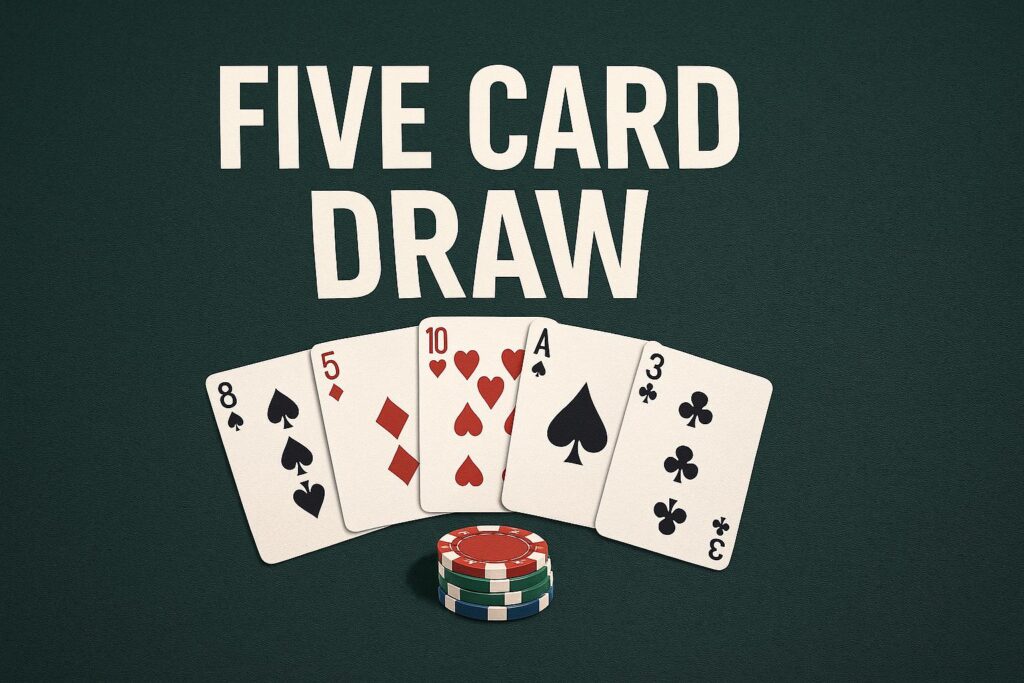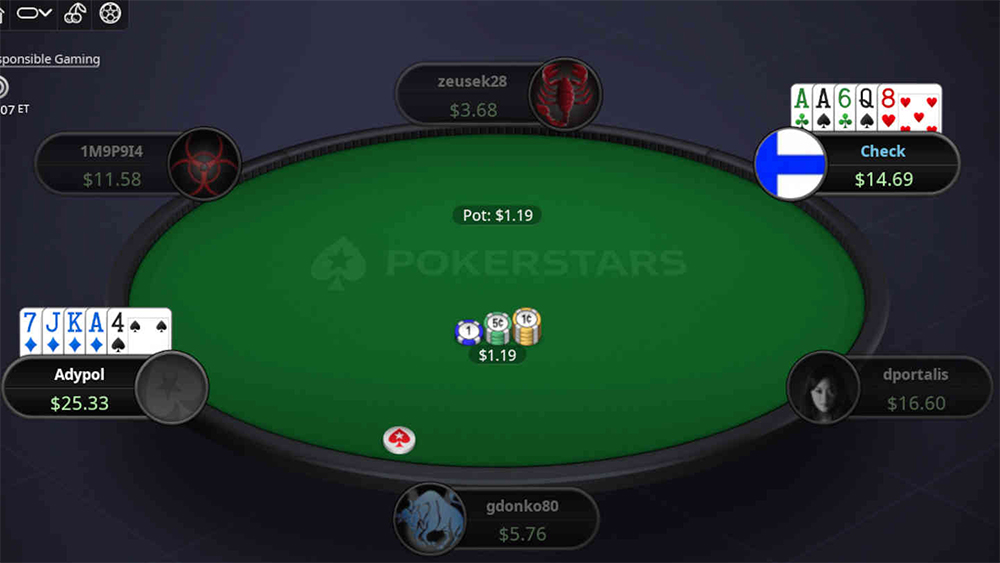5 card draw poker rules & how to play online

Although 5-card draw poker has mostly departed from the modern casino-poker and cardroom-poker scene, it can still be found in many home games and, because of its important place in early poker history, in most of the movies which feature poker or poker scenes.
After all, who can forget Paul Newman turning over four Jacks in The Sting, when his opponent held four Nines (and had thought he had cheated by giving Newman four Threes, only to find he’d been out-cheated)?
Most of the poker scenes found in various old Westerns also feature 5-card draw, in part because the game was indeed played much more often then, but primarily because the movie watcher (who probably knew little about poker) could see a player’s entire hand all at once.
With games such as Hold ’em and 7-card stud, the mechanics of showing viewers hole cards and up cards produced too great a challenge, especially when the movie really wasn’t about poker, but about good guys and bad guys, winning and losing, and the post-game gunfight.
While this very lack of complexity led to draw’s downfall as a casino poker game, it makes draw a fairly good place for new poker players to begin. As with all games, the hand ranks (a flush beats a straight, etc.) remain the same.
Five-Card Draw Poker rules
Five card draw is a simple game to learn but can take some time to master. Understanding the rules of Five Card Draw cannot be done without understanding the gameplay.
Below we have broken down 5-card draw poker rules into several steps: The Beginning, First round of betting, Drawing cards and the final round of betting, or the showdown.
Beginning the game
Draw begins with each player placing an ante into the pot. For our sample game, we’ll assume we are playing 5-10 draw ($5 and $10 bets) with a $1 ante, and that we are playing with seven players. The pot will thus start off with $7 in it.
The dealer deals five cards to each player, ALL of which are face down. In draw, unlike the other games we’ve seen, no one sees any of anyone else’s cards until the hand is over and it’s time to see who has won. As a result, there is much less hard, solid information available to the players about who holds what kind of hand. More subtle clues such as the size of the bet, the nervousness of the player, and how many cards he drew thus become more important, as does bluffing.
This is another reason draw poker is a movie-maker favourite, because player emotion and player personality are much more easily understood by an audience than technical matters such as whether a pair and a flush draw is a better hand than two pair.
First round of betting
The player to the dealer’s left begins the betting, with an option to bet (in our sample hand, $5), or to check . If the first player bets, the second player can no longer check; his options are only to call or to raise. As with the other games we’ve seen, there is usually a limit of three raises per round.
After the initial round of betting, the players remaining in the hand have an option to replace cards in their hand with new cards. The player to the dealer’s left is the first to draw (if he wishes), and then the other players draw in turn.
To draw new cards, a player first selects the cards he wishes to throw away, removes them from his hand, and gently slides or tosses them to the dealer, simultaneously announcing how many cards he wants (which is always the same number as the number of cards he’s thrown away).
The gameplay: Drawing Cards
The rules governing how many cards a player can draw vary. In some games, a player can draw five completely new cards, although it’s impossible to imagine a situation where this would be a smart play. In some games a player can draw four new cards if the lone card he retains is an Ace. This isn’t a good play, either, for two reasons. First, to draw the four cards, the player must show everyone that he has an Ace, which is giving a lot of information away.
Even if this “show the Ace rule” is not used – and it usually isn’t, in casino poker – it would be a bad play to draw four cards. Unless you are playing with total rookies, everyone will know you are drawing four cards to an Ace anyway, and a hand that needs that much help should be folded before the draw. Most of the time, then, players will draw three, two, one, or no cards. A player who draws no cards is said to be “pat”. This creates the impression that he has a strong hand such as a straight, a flush, or a full house.
Sometimes in an effort to be tricky, and/or create the impression of strength, a player who holds two pair or three of a kind will draw no cards. This player is giving up a potentially very useful and important chance to improve their hand, in return for creating the appearance of even more strength than they actually have.
For similar reasons, sometimes a player holding a completely worthless hand will draw no cards, and hope that this appearance of strength, combined with strong betting and raising, will win the pot by making everyone else fold. Usually such a play can work only in a no-limit game, where the player can bet everything he has, and is for reasons that should hopefully be obvious, very risky. Beginning players should avoid these extremely risky bluffing plays and try to focus on drawing to good hands.
Final betting round and showdown
After everyone has drawn their cards, there is a second and final round of betting, at the higher level (here, $10). The player who opened the betting on the first round starts the betting on the second round, and may bet or check.
After all the betting, calling and raising is completed, the hand is over, and if more than one player remains, the players lay their cards on the table so everyone can see who wins the pot. If one player has bet or raised, and is not called by anyone else, he wins the pot and does not have to show his hand to anyone else.
Five-Card Draw Poker strategy
Five-card draw strategy balances hand selection, reading opponents, and smart betting. Starting hand choice is critical. Premium hands like a made flush, straight, full house or four of a kind should almost always be played aggressively. Strong drawing hands – three of a kind, four to a straight, or four to a flush – are generally worth continuing with, especially in games with multiple opponents and good pot odds. Weak starting hands such as unsuited, disconnected cards should usually be folded early.
The draw is where many decisions are made. Drawing one or two cards normally represents strength and can pressure cautious players. Drawing three often signals a weak hand, but it can occasionally be used to disguise a planned bluff. Efficient players keep track of how many cards others discard, which helps narrow down possible hand ranges. If several players draw one card, it increases the chance that someone hit a strong improvement.
Position and betting patterns matter just as much as the cards. Players acting later in the betting round gain valuable information and can make more informed decisions. Bluffing also plays a key role in five-card draw, but it should be used sparingly and in the right situations, such as when your draw pattern convincingly represents a strong hand. Discipline and careful observation are the long-term keys to success.
How to play 5-Card Draw poker online

5-card draw can be played at various online poker sites every day of the year. While it is not as prevalent as Texas Hold’em it still has a strong following both online and off.
Pokerstars, GGPoker (GGPoker review) and 888Poker (888Poker review) all have tables open for 5-Card Draw games at the time of writing, with these generally on the lower-end price-wise to enter. There can however often be high stakes games, but they might not be as frequent as other versions of online poker.
The best poker sites featuring 5 Card Draw can be accessed via both desktop computer and mobile, with many of these real money websites having apps available.
There are several free poker sites that can be a good place to get a grounding in 5 card draw poker, with these including Pokerstars and CardzMania.



